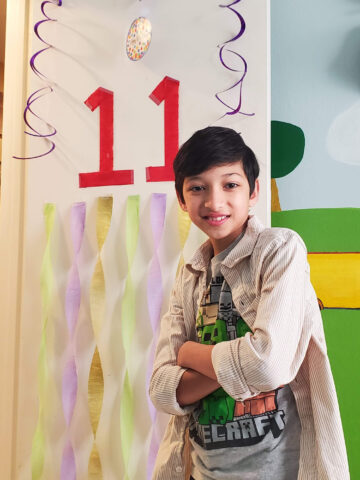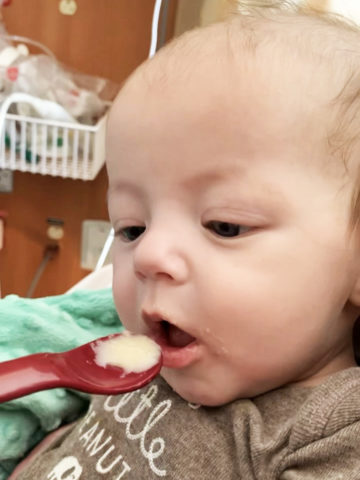Kids and speech problems
Young children often struggle with pronouncing words correctly as they learn language skills. There’s a wide range of what’s considered normal when it comes your child’s early language skills.
However, if you think your child is having trouble communicating, don’t ignore your concerns. It’s important for children to develop an early understanding and expression of language so that their other developmental skills — like play and social interaction skills — aren’t delayed.
Here, Melissa Gran, speech and language pathologist at CHOC, offers guidance speech and language developmental milestones, and teaches parents how to spot warning signs of speech or language delays.
How to encourage language development in young children
“Language learning can easily be incorporated into daily activities. Children are constantly learning language receptively and expressively in all environments,” says Melissa. “It is so important to talk to your children throughout the day, such as when getting them dressed, mealtime and bath time.”
Other ways that parents can encourage language development for their kids include:
- Narrate routines and describe actions during daily tasks.
- Sing songs and recite rhymes together.
- Read together, tell stories and ask questions.
- Play “I Spy” and naming games to expand vocabulary.
- Talk about the world around them, like nature and the people they see.
- Use picture books and flashcards to introduce new words.
- Encourage storytelling and pretend play for language expression.
- Play word games like “Simon says” or “Rhyming words.”
- Use educational apps or online resources wisely.
Speech and language developmental milestones for kids
Knowing what is considered “normal” or not in speech and language development can help you determine if your child is developing on schedule, says Melissa.
The following milestones provide a framework for tracking a child’s language development and ensuring they are reaching appropriate milestones for their age.
| Hearing and understanding | Talking | |
| Birth to 3 months | – Startles to loud sounds. – Quiets or smiles when spoken to. – Seems to recognize caregiver’s voice and quiets if crying. – When feeding, increases or decreases sucking behavior in response to sound. | – Makes pleasure sounds (cooing, gooing). – Cries differently for different needs. – Smiles when sees primary caregiver(s). |
| 4 to 6 months | – Moves eyes in the direction of sounds. – Responds to changes in the tone of the caregiver’s voice. – Notices toys that make sounds. – Pays attention to music. | – Babbling sounds more speech‐like with many different sounds, including p, b and m. – Chuckles and laughs. – Vocalizes excitement and displeasure. – Makes gurgling sounds when left alone and while playing with their caregiver. |
| 7 months to 1 year | – Enjoys games like peek‐a‐boo and pat‐a‐cake. – Turns and looks in the direction of sounds. – Listens when spoken to. – Recognizes words for common items like “cup”, “shoe”, “book”, or “juice.” – Begins to respond to requests like “Come here” or “Want more?” | – Babbling has both long and short groups of sounds such as “Tata, upup, bibibibi.” – Uses speech or non‐crying sounds to get and keep attention. – Uses gestures to communicate (waving, holding arms to be picked up). – Imitates different speech sounds. – Has one or two words “Hi, dog, dada, mama” around first birthday, although sounds may not be clear. |
| 1 to 2 years | – Points to a few body parts when asked. – Follows simple commands and understands simple questions like “Roll the ball,” “Kiss the baby,” and “Where’s your shoe?” – Listens to simple stories, songs and rhymes. – Points to pictures in a book when named. | – Has a word for almost everything. – Uses two‐ or three-words to talk about and ask for things. – Uses k, g, f, t, d, and n sounds. – Speech is understood by familiar listeners most of the time. – Often asks for or directs attention to objects by naming them. |
| 2 to 3 years | – Understands differences in meaning between “go‐stop,” “in‐on,” “big‐little,” and “up‐down.” – Able to follow two requests, like “Get the book and put it on the table.” – Listens to and enjoys hearing stories for longer periods of time. | – Has a word for almost everything. – Uses two‐ or three-word sentences to talk about and ask for things. – Uses k, g, f, t, d, and n sounds. – Speech is understood by familiar listeners most of the time. – Often asks for or directs attention to objects by naming them. |
| 3 to 4 years | – Hears when someone calls them from another room. – Hears television or radio at the same loudness level as other family members. – Answers simple “who?,” “what?,” “where?” and “why?” questions. | – Talks about activities at school or at friends’ homes. – People outside of the family usually understand child’s speech. – Uses a lot of sentences that have four or more words. – Usually talks easily without repeating syllables or words. |
| 4 to 5 years | – Pays attention to a short story and answers simple questions about them. – Hears and understands most of what is said at home and in school. | – Uses sentences that give lots of details (“The biggest peach is mine”). – Tells stories that stick to topic. – Communicates easily with other children and adults. – Says most sounds correctly except a few like l, s, r, v, z, ch, sh, th. – Says rhyming words. – Names some letters and numbers. – Uses the same grammar as the rest of the family. |
Signs of developmental delays in speech and language for kids
Recognizing the signs of speech or language delays in children is important for early intervention and support.
Here are some general signs that may indicate that your child has a speech and language delay:
- Lack of babbling (around 6-9 months).
- Limited vocabulary (by 18 months).
- Difficulty combining words (around age 2).
- Lack of response to verbal cues.
- Limited social interaction.
- Pronunciation difficulties.
- Trouble understanding stories or instructions.
It’s important to discuss any concerns with your pediatrician at every routine well-check visit.
What to do if you think your child has a speech or language disorder
Again, make sure to always talk to your child’s doctor about any developmental concerns at every well-check visit.
First, your child’s hearing should be checked. This is to make sure that he or she isn’t simply hearing words and sounds incorrectly.
If hearing loss is ruled out, your child’s doctor may refer you to a speech-language pathologist. This is a speech expert who evaluates and treats children who are having problems with speech-language and communication.
The diagnosing process involves initial screening, case history, observation, formal assessment, language sample analysis and additional evaluations if necessary.
Learn more about motor speech disorders
When to seek speech or language therapy
There are many reasons a child should be referred for speech or language therapy. Many families are surprised to find out their child needs speech or language therapy, as they often chalk up their child’s speech-related problems to not listening or just a cute “quirk.”
It is also common for parents to be so focused on a child’s other medical conditions or therapy needs that they overlook those that require speech and language therapy.
Remember that you are an expert on your child, says Melissa. Use these speech and language developmental milestones for guidance but reach out to your pediatrician with any questions and concerns.
By addressing any potential delays early on, you’ll set your child up for getting the help they need to develop their communication skills successfully.
Learn more about speech and language pathology at CHOC
Speech and language pathology is specialized therapy that helps children develop or improve their speech, language, memory and attention, feeding and swallowing.





